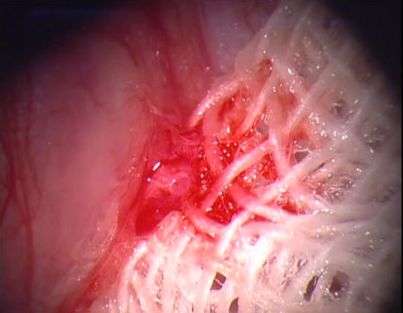7-8 weeks after transplantation, urine from the transplant-grown bladder was continuously discharged from the connected host ureter.
(Medical Xpress)—A team of researchers affiliated with several institutions in Japan has succeeded in growing kidneys from stem cells that worked as they were supposed to after being transplanted into rats and pigs. The team outlines their work and results in a paper they have had published in Proceedings of the National Academy of Sciences.
Researchers have met with success in the past, using human stem cells to grow organs, in this case kidneys, unfortunately, the kidneys that have been grown have all developed without a urinary pathway—the means by which urine makes its way out of the kidney and to a tube that connects with the bladder. Such kidneys experience hydronephrosis, where they bloat with urine. In this new effort, the researchers found a way to grow both a kidney and a pathway and an initial bladder, all of which successfully replicated the work normally done by natural organs for a period of time.
The team used the organogenic niche method to grow kidneys using rat stem cells, which when tested, were able to produce urine. Next, they grew a urinary pathway, which was in effect, a type of drainage tube. Then, they grew a blabber that would be compatible with the drainage tube. With all the parts, grown, the kidney was placed inside a rat, then the pathway was added, followed by the bladder they'd grown—the new bladder was then connected to the rat's native bladder. After sewing up the rat, they found the whole system worked. The team then repeated what they had done with a much larger animal, one much closer in size to humans—a pig—and found the same results.
Urine excretion from a bladder grown after a cloacal transplant. Seven to eight weeks after cloacal transplantation (3–4 wk after ureter–bladder anastomosis), urine from the bladder grown after a cloacal transplant discharged continuously from the connected recipient ureter. Credit: PNAS, Shinya Yokote, doi: 10.1073/pnas.1507803112
The team is quick to point out that their work does not in any way prove that their technique would work in humans, and add that even if everything continues to go well, growing and implanting similar parts into people wouldn't come before a lot of time has passed—there is still a lot of work to do, such as seeing how well the organs work in the long term, testing to make sure they don't become cancerous, etc. They note that there is also still a lot of ongoing research looking into ways to use stem cells to rejuvenate damaged organs, a process that would most likely be quicker than growing whole new organs for people who need them in a hurry.
More information: Urine excretion strategy for stem cell-generated embryonic kidneys, PNAS, Shinya Yokote, DOI: 10.1073/pnas.1507803112
Abstract
There have been several recent attempts to generate, de novo, a functional whole kidney from stem cells using the organogenic niche or blastocyst complementation methods. However, none of these attempts succeeded in constructing a urinary excretion pathway for the stem cell-generated embryonic kidney. First, we transplanted metanephroi from cloned pig fetuses into gilts; the metanephroi grew to about 3 cm and produced urine, although hydronephrosis eventually was observed because of the lack of an excretion pathway. Second, we demonstrated the construction of urine excretion pathways in rats. Rat metanephroi or metanephroi with bladders (developed from cloacas) were transplanted into host rats. Histopathologic analysis showed that tubular lumina dilation and interstitial fibrosis were reduced in kidneys developed from cloacal transplants compared with metanephroi transplantation. Then we connected the host animal's ureter to the cloacal-developed bladder, a technique we called the "stepwise peristaltic ureter" (SWPU) system. The application of the SWPU system avoided hydronephrosis and permitted the cloacas to differentiate well, with cloacal urine being excreted persistently through the recipient ureter. Finally, we demonstrated a viable preclinical application of the SWPU system in cloned pigs. The SWPU system also inhibited hydronephrosis in the pig study. To our knowledge, this is the first report showing that the SWPU system may resolve two important problems in the generation of kidneys from stem cells: construction of a urine excretion pathway and continued growth of the newly generated kidney.
Journal information: Proceedings of the National Academy of Sciences
© 2015 Medical Xpress






















